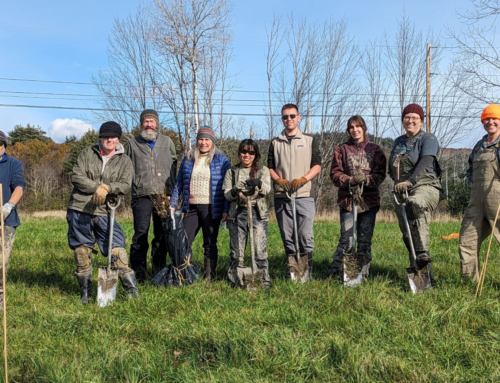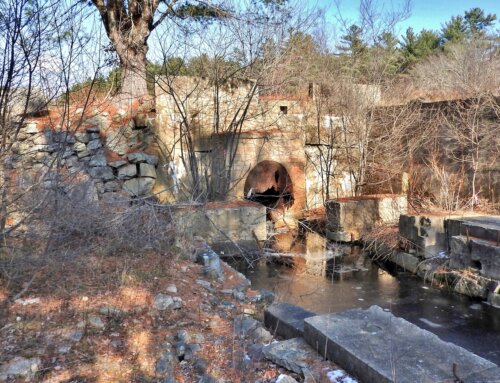It was an incredible Earth Day around the Connecticut River, and we’re here to summarize all the activities that CRC was involved in along with many dedicated volunteers and regional conservation partners. The primary areas of work included river cleanups, cyanobacteria mitigation, and tree-planting!
Cleanups to Reduce Pollution
While CRC’s largest cleanup initiative is the Source to Sea Cleanup in early fall, picking up trash is an incredibly important activity any time of year. Spring reveals lots of debris that may have accumulated over the winter months and helps identify areas where more concerted efforts are needed to protect healthy habitats.
In the Meadows area in Northampton, 12 volunteers organized by CRC Volunteer Group Leader Victoria Quill collected a whopping 1,200 lbs. of trash in under 3 hours! Some unique items collected include shotgun shells, bullets, umbrella, bumper, storage container, bathroom tiles, shingles, and a hula hoop. Common items include 9 tires and many beverage/food containers.
We would also like to thank the following groups for coordinating independent cleanups: Deep River Sustainable Committee, Westfield River Watershed Association, Spruce it Up Colrain, Leverett Community Builders, and others.
The Green Team at Saybrook Point Resort & Marina also included representatives from all departments within the resort for a coastal cleanup. They removed 15 bags of trash from a town beach, the adjacent parking lot, and a marsh next to a causeway close to their property in Old Saybrook.
And the staff at Audacy participated as part of their 1 Thing Sustainability Initiative. They had 21 volunteers covering almost 2 miles of the Connecticut River in East Hartford, as well as the Riverwalk near the Basketball Hall of Fame in Springfield, resulting in 17 large and heavy trash bags collected. Strangest items found were single shoes and a boot, a broken sledge hammer, and fake rose petals with tealight candles.
Planting Trees and Stems for Hartford
Reforesting our cities is one of the best ways to support healthy communities, increase biodiversity, and reduce the impact of climate change. That’s why Connecticut River Conservancy joined On Earth Hartford and Keney Park Sustainability Project in Windsor to transplant stems and saplings for a nursery that will benefit the park and tree canopy in Hartford, CT.
Over 30 volunteers came out to transplant 320 saplings, including river birches and silver maples. Transplanting at this stage in the young trees’ growth will provide the right conditions for them to mature and develop strong root networks so that they have the highest possible chance of survival when they’re planted in the ground to support Hartford’s canopy as well as riverbanks in the area.
After the planting, our River Steward for Connecticut, Rhea Drozdenko, moderated a panel discussion titled Engaging Community for the Earth, a conversation about the importance of involving community in environmental work, and how folks can advocate and engage others. The panel also included Samuel King from Blue Earth Compost, Jonathan Humphrey from Natural Dividends, Kirsten Martin from the University of St. Joseph, and Ally Gelinas from KNOX.
Cyanobacteria Mitigation in Nashawannuck Pond
Harmful algae blooms (HAB) such as toxic cyanobacteria blooms are increasing dramatically worldwide, including in the Connecticut River Watershed, due to pollution, chemical saturations in bodies of water such as ponds and lakes, and rising temperatures. HABs are toxic to animals (including fish, birds, livestock, humans, and dogs) and are disruptive of healthy ecosystems.
Barley straw is proven to be effective as an algistat against algae blooms by reacting to the water. A group of partners in Western Massachusetts who are concerned about HAB’s came together to introduce barley straw to local ponds. In order for barley straw to be effective against algae blooms, straw bales need to be installed in the ponds in the spring, where they remain until the fall. And that’s exactly what we did on Earth Day in Nashawannuck Pond in Easthampton, MA.
Thanks to the help of over 20 volunteers, the Nashawannuck Pondsteering committee, US Fish & Wildlife, and the City of Worcester, we packed 132 barley straw bales and installed them across 10 locations around Nashawannuck Pond. From here, we will continue to monitor the effectiveness of this mitigation approach using a CyanoFluor that can detect presence of cyanobacteria in a sample. By gathering water quality data we can understand how to help reduce HAB’s in other parts of the watershed.
Earth Day is Just the Beginning of Field Season!
While Earth Day may be a fantastic way to get involved with environmental action, it’s only just the start of the field season ahead and all that our programs work has in store for this year.
Here are all the ways you can keep the momentum going through the rest of the year:
















